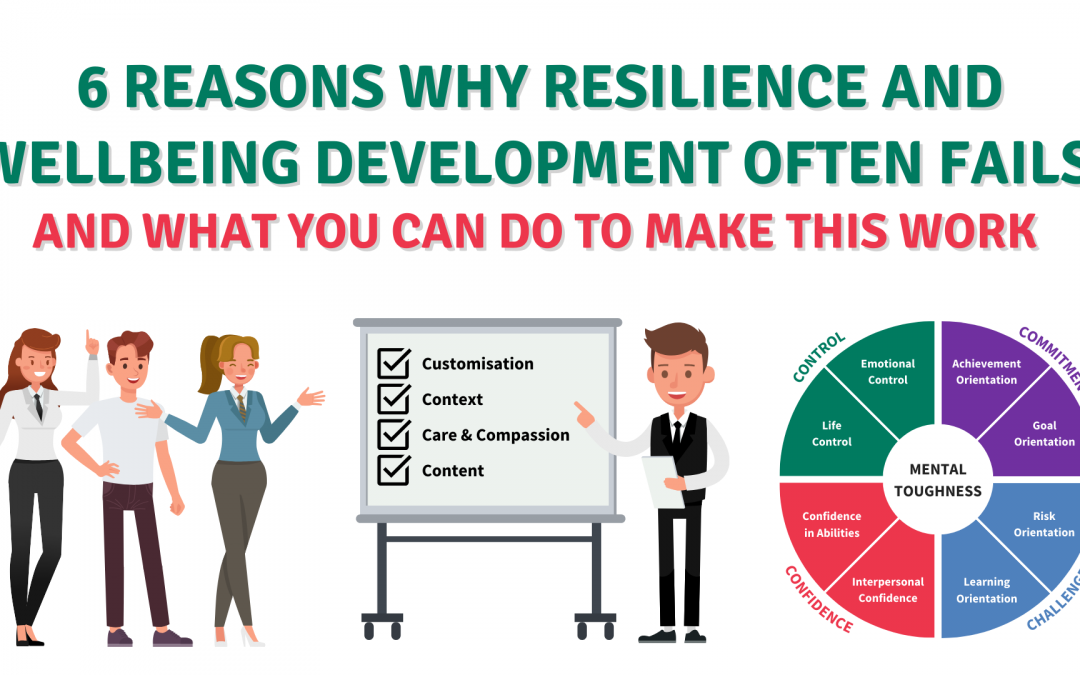In March 2023, a paper from Oxford University* found that resilience and wellbeing programs in 143 UK organisations failed to deliver satisfactory results and some did more harm than good.
Another study on wellbeing programs in the Dutch Police Service, using the MTQ+**, found similar.
This does not mean that resilience, mental toughness, or wellbeing programs cannot or do not work. They can and often do!
So why do so many Resilience And Wellbeing programs fail and what do we need to do to get it right?
Both studies point to the same things.
- Although the programs are nominally directed at the individual they are not customised. Both studies found the same thing “One size doesn’t fit all”.
- In focusing on the individual and not doing what the organisation can to minimise stressors, employees can feel that “it’s their fault” that they are stressed.
We know this and yet it is still ignored. The generic one-size-fits-all can appear to be a quick, efficient and cost-effective solution – however, if it does not work then none of this is true.
Should practitioners use a bespoke tailored method to enhance the effectiveness of mental toughness training? We believe so and incorporate it with success in our work.
There are six elements we can work on to do this, and other forms of Resilience And Wellbeing development, better.
- Just because I have a solution does not mean it works for everyone and every time. The temptation to provide an off-the-shelf solution is sometimes driven by the fact that the provider has expertise with a solution that they try to fit all situations. It is the client’s need that matters; the solution must spring from that.
- If it is not right for the individual, don’t do it. Building on the first point, the client and their needs come first. The research shows that not enough practitioners customise their offerings by assessing the client’s needs beyond the superficial and delivering to those needs.
- Fitting the job to the person. Sometimes providers take the view that coping deficits are down to the individual – it is their failing. Is there a way to reduce the stressors? It is unlikely that all stress can be removed but interventions should be established within the wider organisational context. Personal development should not be there to mitigate against obstacles presented by the organisation.
- Most interventions work – but not for all people and not all the time. It is essential to factor in the needs and experience of the client rather than giving them what you have. Studies show that a client’s mental approach to (their mental toughness) can influence the effectiveness of those interventions. Just because it worked last time doesn’t mean it will work next time.
- A large-scale generic intervention programme will work for some people and not for others. Celebrating the few successes does not mean that it was successful for all. Worryingly, research suggests it sets some back. The same resource, targeted at need, can often be a better solution.
- If it isn’t broken – don’t fix it. Not what it seems at first sight, it means that you do not try new approaches, tools etc just because they are new. Clients will often ask for “something new” or “something different” when an existing approach can do the job and things are OK.
Continuous improvement is important – it means trying to do it better even if it seems to work but with approaches that have evidence behind them and for a purpose.
Surely, we already know this! It is so often mentioned. It appears that many practitioners may know this, but they may not fully understand it and its implications for success.
The use of the mental toughness concept and measure to create awareness about an individual’s mental responses can address many of these elements.
We talk about the 4Cs of effective interventions. The best, reflecting research, should show:
Customization – the research shows that when this is missing, the intervention fails. The mental toughness concept and the MTQ measures provide the capability to both understand the individual and to enable self-awareness in the individual about why, mentally, they thrive or struggle at times.
Context –It is important to understand the sources of stress and pressure – whether these are caused by people or processes, and to purposefully set about reducing or eliminating them.
The mental toughness concept usefully connects the individual perspective with the organisational.
Care and Compassion – an initiative which purports to help the individual must be delivered in a way that the employee believes that this is primarily for their benefit and that the initiator genuinely understands and cares for their wellbeing. This is a leadership challenge.
Content – should be developed from materials for which there is sound independent evidence, and which can be shown to be relevant to the challenge. Just because it’s popular does not mean that it works everywhere or at all.
For those who like to tick boxes, if you can tick all four boxes, you stand a very good chance of success and improving wellbeing and that outcome – performance – for everyone’s benefit.
For information about becoming a licensed user of the MTQ suite of measures contact: headoffice@aqrinternational.co.uk
The MTQPlus measure is available in fourteen languages, accessible to more than 2/3rds of the world’s population.
Completion of the AQR Licensed user training programme is recognised by EMCC and ICF for CPD purposes.
** https://link.springer.com/article/10.1007/s11896-017-9247-8


